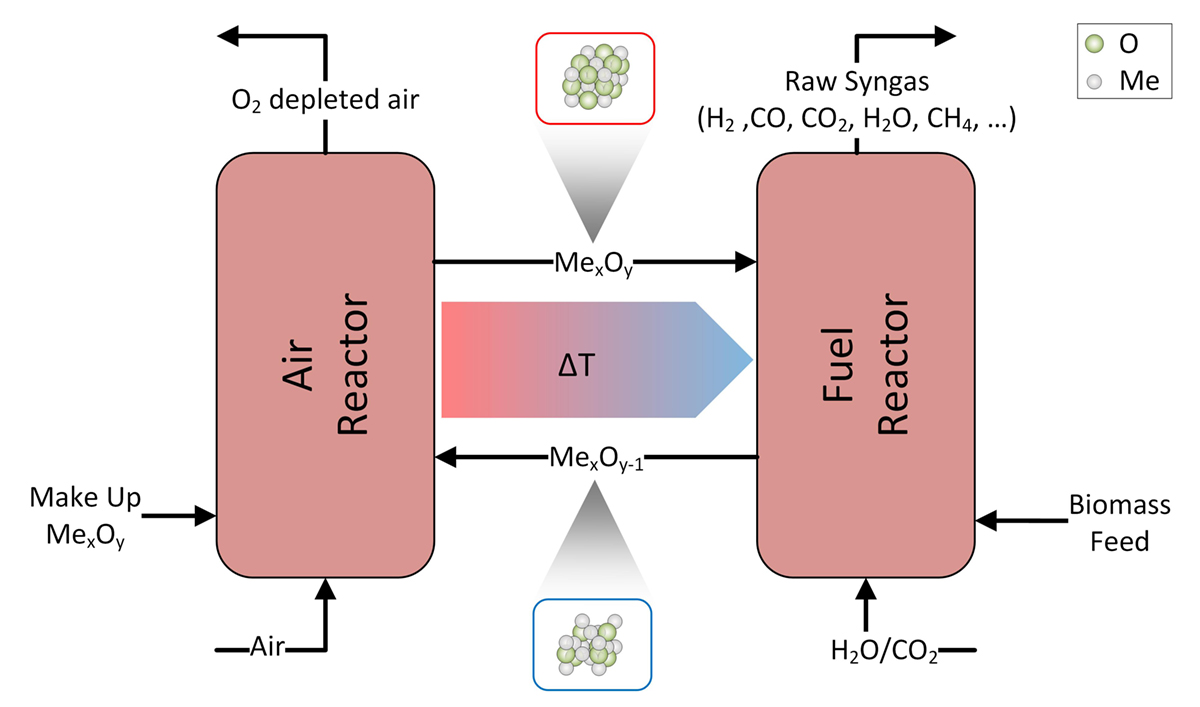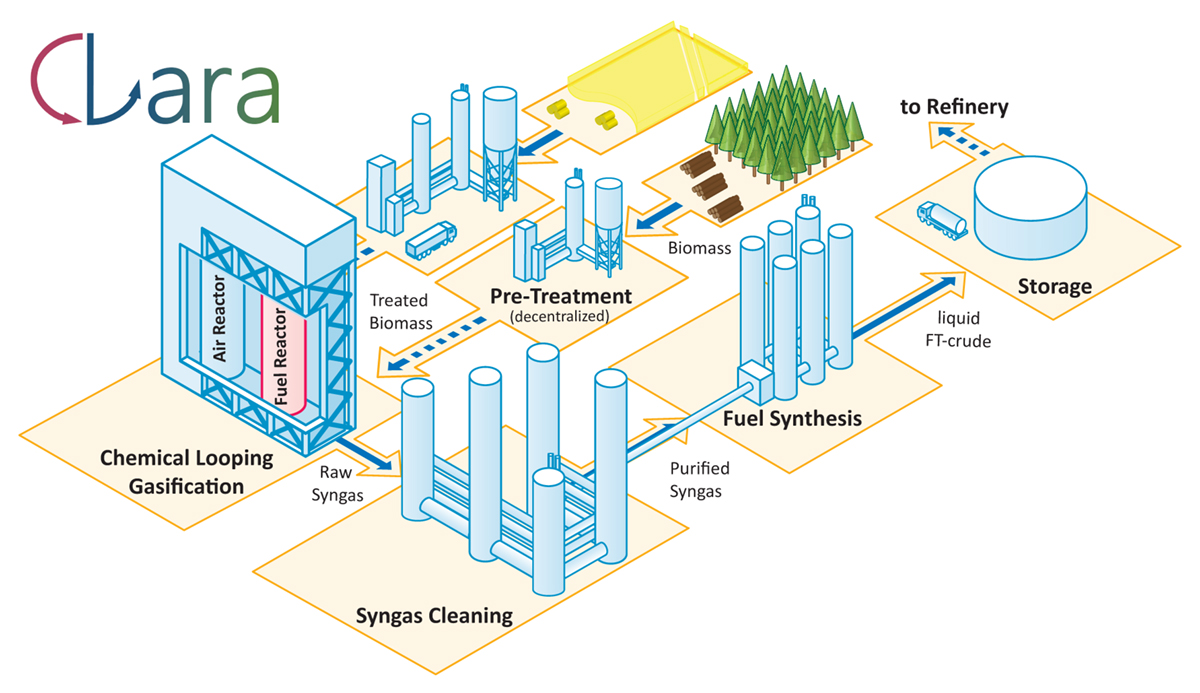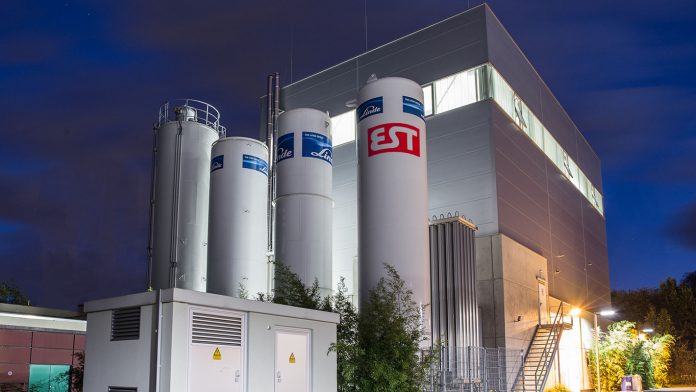Learn how Chemical Looping Gasification has a high potential for sustainable and economic production of biofuels from biogenic residues
Alleviating the negative impacts of the energy-intensive heavy freight transport and aviation industry on the environment is a key obstacle that needs to be overcome on the way towards a carbon-neutral society. This has also been acknowledged by the European Commission, which has launched the renewable energy directive (REDII)1, encouraging the pursuit of auspicious pathways for producing so-called 2nd generation biofuels for sectors where electrification is currently not viable. In contrast to conventional biofuels, 2nd generation biofuels can be derived from biogenic residues, which means that their large-scale production does not go in hand with detrimental effects on food availability and prices.
Biofuels through gasification
Gasification is a well-known thermochemical conversion strategy, allowing for the production of a high calorific synthesis gas from virtually any solid carbon-based material, which is why it is considered to be a crucial building block in future 2nd generation biofuel process chains. A nitrogen-free syngas is a prerequisite for fuel synthesis, which can be achieved by the deployment of pure oxygen in gasification processes embedded in biomass-to-biofuel process chains. The provision of this oxygen requires an air separation unit, which is associated with large energy demands as well as high capital and operational costs, hence adversely affecting the process efficiency and the economics of the value chain. Hence, new gasification technologies without the need for air separation are urgently needed.

The CLARA project
An efficient technology for the production of liquid fuels based on chemical looping gasification (CLG) of biogenic residues is being developed within the scope of the EU-funded Horizon 2020 project CLARA2, executed by an international consortium consisting of thirteen partners from academia and industry. In chemical looping, pure oxygen for feedstock conversion is provided through the cyclic reduction and oxidation of a circulating oxygen carrier material (see Figure 1). Hence, CLG facilitates the efficient conversion of biogenic feedstocks into a high-calorific and N2-free synthesis gas, without relying on a costly air separation unit.
The CLARA project combines CLG with other innovative technologies related to feedstock pre-treatment, enabling the use of low-grade biogenic residues for gasification, and raw gas cleaning, lowering capital and operational expenditures by 30 % compared to state of the art gas cleaning technologies. This process chain allows for significantly reduced biofuel production costs, so that cost-competitive drop-in fuels (0.7 €/l) can be realised.
Moreover, the suggested process chain, schematically shown in Figure 2, facilitates the efficient capturing of the incurring by-product CO2, which means that biofuels exhibiting a negative carbon footprint are obtained, in case the captured CO2 of biogenic origin is being sequestered (CCS) or further utilised (CCU). These aspects, in combination with projected advances in terms of process scalability, make the suggested process chain an auspicious carbon-negative value chain, promising an efficient de-carbonisation of the transport sector, while at the same time guaranteeing market compatibility.

Current research
The individual novel technologies of the process chain are currently being studied and optimised in lab and bench scale units. First results indicate that low-cost natural ores are well suited as oxygen carrier materials for CLG. Pre-treatment methods, such as torrefaction and leaching, can raise the ash softening temperature and thereby qualify cereal straw as a feedstock for CLG. Furthermore, the basic principle of sulfur recovery through an innovative syngas cleaning concept has been successfully demonstrated.
The next step is to investigate the entire biomass-to-biofuel process chain in the MW scale, using the unique pilot plant located at the Technical University Darmstadt (see Figure 3). The insights gained during these test campaigns, conducted in an industrially relevant environment, will further propel the novel technologies towards market maturity, hence substantially accelerating the large-scale market introduction of renewable 2nd generation biofuels produced via thermochemical conversion of biogenic residues.
1 “DIRECTIVE (EU) 2018/ 2001 OF THE EUROPEAN PARLIAMENT AND OF THE COUNCIL – of 11 December 2018 – on the promotion of the use of energy from renewable sources,” p. 128.
2 This project has received funding from the European Union’s
Horizon 2020 research and innovation programme under grant agreement No 817841.
CAPTIONS:
Figure 1: Chemical looping gasification
Figure 2: Suggested biomass-to-biofuel process chain
Figure 3: The 1 MWth pilot plant located at TU Darmstadt, Germany
Please note: This is a commercial profile











